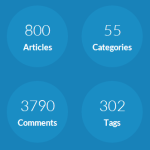The iron triangle in project management tells us that a product is the result of…
Getting Square with the Iron Triangle
Here’s a little quiz for those who aspire to be a project manager. (Probably 95% of my readers will stop reading here right now. But no matter, I will finish this post for the other 5% of you…)
Question 1: Which constraints do customers impose on projects?
Of course, almost everyone knows this. The three constraints are Scope, Time and Cost. The customer wants to know what he’s going to get, when he’s going to get it, and how much he’s going to pay for it.
This is called the Project Management Triangle, or the Iron Triangle. So far so good. You get 1 point if you knew this. Here’s the next question…
Question 2: Why is this triangle useless for project managers?
Well, let’s see. What if new features are added to the scope? In that case, as a project manager, you must decide whether to add more time or more resources (or both). But the triangle doesn’t show that! It only shows cost. But cost = time * resources. For you, as a project manager, the triangle is defective because it shows the constraints from the customer’s viewpoint. The customer doesn’t care about your resources, he just cares about the cost! Project managers have another viewpoint on the project, and therefore another triangle:
This version (copied from Scott Ambler) is slightly better for us project managers. It properly reflects that when scope is increased, we need either more time or more resources. This version may not work for your customer, but it does for you! You never realized that, did you? If you did, good for you! You get 3 points! Next question…
Question 3: Why is this triangle useless for quality managers?
OK, let’s see. What happens when we add new features without changing any of the two other sides? In that case the quality of the product will inevitably be the victim. But why is quality printed in the middle? That’s silly. Quality is a constraint, just like the others. In fact, scope is often defined as scope = functionality + quality. So, it seems we can simply split scope into two different contraints, and it turns out that we are changing the triangle into a square.
The Iron Square is a much better representation of the constraints in your project! When functionality is added, either resources or time must increase, or else quality goes down. When time is decreased, then either functionality must go down too, or the resources must go up. If neither is done, then quality goes down again. And similarly, when resources are taken away from you, then either the functionality must go down as well, or the time must go up. Or else quality goes down again.
The Iron Square is like a real sturdy piece of metal. You cannot bend or break it. If you tip one corner of the square, then either one or both of the adjacent corners have to tilt in the same direction, or else the constraint that is placed diagonally across goes the other way, whichever way you look at it. Did you already know that? 5 points if you did!
I must admit that there are other variants of the four contraints, like the star and the tetrahedron versions. (2 bonus points if you knew that.) But personally, I don’t think they are as powerful as the simple square.
Question 4: Why is this triangle useless for process managers?
It’s because, even with all four contraints fixed, it is still possible to optimize a project by improving the process. Process is an extra dimension on the project, but it’s not a constraint. You get 1 point if you knew this.
So, how many points did you score?








